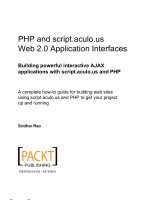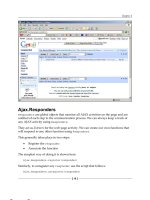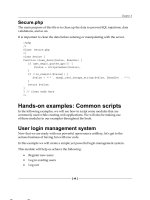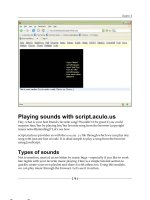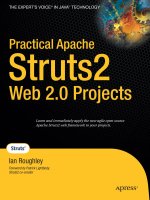Practical Apache Struts2 Web 2.0 Projects retail phần 9 potx
Bạn đang xem bản rút gọn của tài liệu. Xem và tải ngay bản đầy đủ của tài liệu tại đây (515.29 KB, 36 trang )
String dropExtension(String name) {
Iterator it = knownExtenstions.iterator();
while (it.hasNext()) {
String extension = "." + (String) it.next();
if (name.endsWith(extension)) {
return null;
}
}
return name;
}
public ActionMapping getMapping(
HttpServletRequest request, ConfigurationManager configManager) {
// from DefaultActionMapper
ActionMapping mapping = new ActionMapping();
String uri = getUri(request);
uri = dropExtension(uri);
if (uri == null) {
return null;
}
parseNameAndNamespace(uri, mapping, configManager);
handleSpecialParameters(request, mapping);
if ( mapping == null || mapping.getName() == null) {
return null;
}
// from Restful2ActionMapper
String actionName = mapping.getName();
if (actionName != null && actionName.length() > 0) {
int lastSlashPos = actionName.lastIndexOf('/');
// try to guess using REST-style patterns
if (mapping.getMethod() == null) {
if (lastSlashPos == actionName.length() -1) {
// Index, e.g., foo/
if (isGet(request)) {
mapping.setMethod("index");
CHAPTER 9 ■ SYNDICATION AND INTEGRATION268
9039ch09.qxd 10/29/07 3:26 PM Page 268
// Creating a new entry on POST, e.g., foo/
} else if (isPost(request)) {
mapping.setMethod("create");
}
} else if (lastSlashPos > -1) {
String id = actionName.substring(lastSlashPos+1);
// Viewing the form to create a new item, e.g., foo/new
if (isGet(request) && "new".equals(id)) {
mapping.setMethod("editNew");
// Viewing an item, e.g., foo/1
} else if (isGet(request)) {
mapping.setMethod("view");
// Removing an item, e.g., foo/1
} else if (isDelete(request)) {
mapping.setMethod("remove");
// Updating an item, e.g., foo/1
} else if (isPut(request)) {
mapping.setMethod("update");
}
if (getIdParameterName() != null) {
if (mapping.getParams() == null) {
mapping.setParams(new HashMap());
}
mapping.getParams().put(getIdParameterName(), id);
}
}
if (getIdParameterName() != null && lastSlashPos > -1) {
actionName = actionName.substring(0, lastSlashPos);
}
}
// Try to determine parameters from the URL before the action name
int actionSlashPos = actionName.lastIndexOf('/', lastSlashPos - 1);
if (actionSlashPos > 0 && actionSlashPos < lastSlashPos) {
String params = actionName.substring(0, actionSlashPos);
HashMap<String,String> parameters = new HashMap<String,String>();
CHAPTER 9 ■ SYNDICATION AND INTEGRATION 269
9039ch09.qxd 10/29/07 3:26 PM Page 269
try {
StringTokenizer st = new StringTokenizer(params, "/");
boolean isNameTok = true;
String paramName = null;
String paramValue;
while (st.hasMoreTokens()) {
if (isNameTok) {
paramName = URLDecoder.decode(st.nextToken(), "UTF-8");
isNameTok = false;
} else {
paramValue = URLDecoder.decode(st.nextToken(), "UTF-8");
if ((paramName != null) && (paramName.length() > 0)) {
parameters.put(paramName, paramValue);
}
isNameTok = true;
}
}
if (parameters.size() > 0) {
if (mapping.getParams() == null) {
mapping.setParams(new HashMap());
}
mapping.getParams().putAll(parameters);
}
} catch (Exception e) {
LOG.warn(e);
}
mapping.setName(actionName.substring(actionSlashPos+1));
}
}
return mapping;
}
}
Configuring the action mapper is the same as configuring a Struts2-provided action
mapper and occurs in the
struts.xml configur
ation file. First is a new bean configuration for
the new custom
FallbackRestful2ActionMapper action mapper type; then a new
struts.mapper.idParameterName property configuring the action property id as the unique
identifier for the RESTful calls (i.e., the URL
/event/2 will call setId(2) on the action being
invoked); and finally, the four property configurations that you saw previously, specifying the
fallback action mapper name rather than the restful2 action mapper name. Following is
the complete configuration:
CHAPTER 9 ■ SYNDICATION AND INTEGRATION270
9039ch09.qxd 10/29/07 3:26 PM Page 270
<bean type="org.apache.struts2.dispatcher.mapper.ActionMapper" name="fallback"
class="org.apache.struts2.dispatcher.mapper.FallbackRestful2ActionMapper" />
<constant name="struts.mapper.idParameterName" value="id" />
<constant name="struts.enable.SlashesInActionNames" value="true" />
<constant name="struts.mapper.alwaysSelectFullNamespace" value="false" />
<constant name="struts.mapper.composite" value="struts,fallback" />
<constant name="struts.mapper.class" value="composite" />
Implementing the RESTful Web Service Logic
All that is left is to implement the action, which provides the logic to perform the RESTful
functions that are being requested, and to then configure the action.
To compartmentalize the web service calls, a new
api package will be created with a cor-
responding
/api namespace. A RESTful web service is being implemented to access the Event
object, so an action configuration is required. The action should look familiar except for the
action name, which is
event/* rather than event. This mapping allows for the unique identifier
value to be specified at the end of the URL; the property of the action (for the unique identi-
fier) has been previously configured using the
struts.mapper.idParameterName constant.
<package name="api" namespace="/api" extends="base-package">
<action name="event/*" class="com.fdar.apress.s2.actions.api.EventAction">
<result name="list">/WEB-INF/jsp/api/eventList.jsp</result>
<result name="single">/WEB-INF/jsp/api/event.jsp</result>
</action>
</package>
From the configuration, you’ll notice that only two methods are being implemented, and
from the names, you should be able to guess that one will return a list of events and the other
a single event. The URL
http://localhost:8080/app/api/event/ returns a list of events and
invokes the
index() method, and the URL http://localhost:8080/app/api/event/2 invokes
the
view() method. The resulting action is the following:
public class EventAction extends BaseAction
implements ModelDriven<Event>, Preparable {
private List<Event> results;
private EventService service;
private long id;
private Event event = new Event();
public void setEventService(EventService service) {
this.service = service;
}
CHAPTER 9 ■ SYNDICATION AND INTEGRATION 271
9039ch09.qxd 10/29/07 3:26 PM Page 271
public void setId(long id) {
this.id = id;
}
public long getId() {
return id;
}
public Event getModel() {
return event;
}
public List<Event> getResults() {
return results;
}
public void prepare() throws Exception {
if(id!=0) {
event = service.findById(id);
}
}
public String view() {
return "single";
}
public String index() {
results = service.findAllEvents(10);
return "list";
}
}
■Note When a single event is to be viewed, the work is performed in the prepare() method rather than
the
view() method. This is because in the paramPrepareParamsStack interceptor stack the prepare
interceptor is before the modelDriven interceptor (which only places the model on the
Value Stack if it is
not
null), and by using the prepare() method, the event object is initialized. Alternatively, all the work
could ha
ve been done in the
view() method,
but then each property in the JSP template would need to be
prefixed with model. to reference an initialized object instance.
The final part of implementing a RESTful web service is to implement the JSP templates.
The
eventList.jsp template reuses the listEvents-partial.jsp template from searching.
Because the
listEvents-partial.jsp template doesn’t provide any of the high-level HTML
tags, the
eventList.jsp template needs to provide them:
CHAPTER 9 ■ SYNDICATION AND INTEGRATION272
9039ch09.qxd 10/29/07 3:26 PM Page 272
<html>
<head>
<title><s:text name="api.eventList.title" /></title>
</head>
<body>
<s:include value="/WEB-INF/jsp/search/listEvents-partial.jsp" />
</body>
</html>
The new event.jsp template provides all the information about the event. In this exam-
ple, it is formatted as HTML. This corresponds to the link that we set in the RSS feed item at
the beginning of this chapter so that when the user clicks on the feed link (say
/api/event/2),
it will render event information in a user-friendly way. Here is the JSP template:
<head>
<title><s:text name="api.event.title" /></title>
</head>
<body>
<table>
<tr><td colspan="2"><h1><s:text name="event.title" /></h1></td></tr>
<tr>
<td><s:text name="event.name" /></td>
<td><s:property value="name"/></td>
</tr>
<tr>
<td><s:text name="event.startTime" /></td>
<td><s:date name="startTime" format="MM/dd/yyyy hh:mm"/></td>
</tr>
<tr>
<td><s:text name="event.votingStartTime" /></td>
<td><s:date name="votingStartTime" format="MM/dd/yyyy hh:mm"/></td>
</tr>
<tr>
<td><s:text name="event.duration" /></td>
<td><s:property value="duration"/></td>
</tr>
<tr>
<td><s:text name="event.timeZoneOffset" /></td>
<td><s:property value="timeZoneOffset"/></td>
</tr>
<tr>
<td><s:text name="event.progress" /></td>
<td><s:property value="status"/></td>
</tr>
CHAPTER 9 ■ SYNDICATION AND INTEGRATION 273
9039ch09.qxd 10/29/07 3:26 PM Page 273
<tr>
<td colspan="2"><br/><h3><s:text name="address.title" /></h3></td>
</tr>
<s:if test="location.class.name.endsWith('.Address')">
<tr>
<td><s:text name="address.name"/></td>
<td><s:property value="location.name" /></td>
</tr>
<tr>
<td><s:text name="address.address"/></td>
<td><s:property value="location.address" /></td>
</tr>
<tr>
<td><s:text name="address.city"/></td>
<td><s:property value="location.city" /></td>
</tr>
<tr>
<td><s:text name="address.state"/></td>
<td><s:property value="location.state" /></td>
</tr>
<tr>
<td><s:text name="address.zipcode"/></td>
<td><s:property value="location.zipcode" /></td>
</tr>
</s:if>
<s:else>
<tr>
<td><s:text name="broadcast.name"/></td>
<td><s:property value="location.name" /></td>
</tr>
<tr>
<td><s:text name="broadcast.city"/></td>
<td><s:property value="location.city" /></td>
</tr>
<tr>
<td><s:text name="broadcast.state"/></td>
<td><s:property value="location.state" /></td>
</tr>
<tr>
<td><s:text name="broadcast.network"/></td>
<td><s:property value="location.network" /></td>
</tr>
<tr>
<td><s:text name="broadcast.stationIdentifier"/></td>
<td><s:property value="location.stationIdentifier" /></td>
</tr>
</s:else>
CHAPTER 9 ■ SYNDICATION AND INTEGRATION274
9039ch09.qxd 10/29/07 3:26 PM Page 274
<tr>
<td colspan="2"><br/><h3><s:text name="contestant.title" /></h3></td>
</tr>
<s:iterator value="options" >
<tr>
<td colspan="2"><s:property value="name" /> -
<s:property value="description" /> </td>
</tr>
</s:iterator>
</table>
</body>
</html>
Although HTML is user friendly, it isn’t the best format for the data when interacting
programmatically. The best format in this case is XML (although JSON, JSONP, and other
formats are gaining popularity also). You have several options for creating XML in a Struts2
application: use the xslt result type (especially if you are familiar with XSLT); create the
XML directly in the action (using a library such as XStream from Codehaus); or use the
resulting JSP/Freemarker/Velocity template to generate XML. Because we’ve used JSPs
until now, the final option of using JSP templates is the approach we’ll take.
Generating XML in the JSP template is very easy. In the action configuration, the result
value is changed from
event.jsp to event-xml.jsp, and then the JSP template is created. The
JSP can use any of the Struts2 tags to obtain data, manipulate data, or format data; the only
difference is that the JSP is surrounded by XML tags rather than HTML tags. Following is the
JSP for creating XML:
<%@ page contentType="text/html; charset=UTF-8" %>
<%@ taglib uri="/struts-tags" prefix="s" %>
<?xml version="1.0" encoding="UTF-8"?>
<event id="<s:property value="id"/>">
<name><s:property value="name"/></name>
<startTime><s:date name="startTime" format="MM/dd/yyyy hh:mm"/></startTime>
<votingStartTime>
<s:date name="votingStartTime" format="MM/dd/yyyy hh:mm"/></votingStartTime>
<duration><s:property value="duration"/></duration>
<timeZoneOffset><s:property value="timeZoneOffset"/></timeZoneOffset>
<status><s:property value="status"/></status>
<s:if test="location.class.name.endsWith('.Address')">
<address type="Adress">
<name><s:property value="location.name" /></name>
<address><s:property value="location.address" /></address>
<city><s:property value="location.city" /></city>
CHAPTER 9 ■ SYNDICATION AND INTEGRATION 275
9039ch09.qxd 10/29/07 3:26 PM Page 275
<state><s:property value="location.state" /></state>
<zipcode><s:property value="location.zipcode" /></zipcode>
</s:if>
<s:else>
<address type="Broadcast">
<name><s:property value="location.name" /></name>
<city><s:property value="location.city" /></city>
<state><s:property value="location.state" /></state>
<network><s:property value="location.network" /></network>
<stationIdentifier>
<s:property value="location.stationIdentifier" /></stationIdentifier>
</s:else>
</address>
<contestants>
<s:iterator value="options" >
<contestant>
<name><s:property value="name" /></name>
<description><s:property value="description" /></description>
</contestant>
</s:iterator>
</contestants>
</event>
■Caution Remember to change the decorators.xml file, adding a <pattern>/api/*</pattern>
entry to the excludes tag, to prevent the XML from being decorated with HTML.
The following is the resulting XML when the URL /api/event/3 is invoked:
<?xml version="1.0" encoding="UTF-8"?>
<event id="3">
<name>Boston Marathon 2008</name>
<startTime>04/03/2008 09:00</startTime>
<votingStartTime>04/03/2008 07:00</votingStartTime>
<duration>5</duration>
<timeZoneOffset>-5</timeZoneOffset>
<status>NOT_STARTED</status>
<address type="Adress">
<name>Boston</name>
<address>Main St.</address>
CHAPTER 9 ■ SYNDICATION AND INTEGRATION276
9039ch09.qxd 10/29/07 3:26 PM Page 276
<city>Boston</city>
<state>MA</state>
<zipcode>02140</zipcode>
</address>
<contestants>
<contestant>
<name>Runner 1</name>
<description>Runner 1</description>
</contestant>
<contestant>
<name>Runner 3</name>
<description>Runner 3</description>
</contestant>
</contestants>
</event>
■Caution With the FallbackRestful2ActionMapper installed, the web application’s starting URL is no
longer
http://localhost:8080/app (as this is now a valid URL), and instead needs to be http://
localhost:8080/app/index.action.
Summary
With this chapter, boundaries have been broken, and a self-contained web application has
been opened up to interact with both people and processes on the Internet.
You have learned how to produce an RSS feed; how to geo-code physical address infor-
mation into latitude and longitude; ho
w to include latitude and longitude information using
a standard format; and how to consume the RSS feed to provide a mashup that is completely
external to the application or that resides within the application. Web service functionality
was also discussed, concluding with an implementation of a RESTful-style w
eb ser
vice.
Even more important than the technologies themselves is that you have learned new
ways to integrate new services into the Struts2 framework. In producing an RSS feed, you
learned how to implement a new result type, and in producing a RESTful web service, you
lear
ned how to implement a new action mapper, which maps a URL to an action configura-
tion and vice versa. N
o
w that y
ou understand and can use the integr
ation points, such as
these
, y
ou can take adv
antage of the r
eal po
w
er of open sour
ce pr
ojects
. Armed with this
kno
wledge, you will be able to find new and easier ways to implement the new features that
y
our applications r
equir
e
.
CHAPTER 9 ■ SYNDICATION AND INTEGRATION 277
9039ch09.qxd 10/29/07 3:26 PM Page 277
9039ch09.qxd 10/29/07 3:26 PM Page 278
AJAX
In many ways, AJAX is synonymous with a Web 2.0 application. The term AJAX, originally an
acronym standing for Asynchronous JavaScript and XML, was coined by Jesse James Garrett in
2005, although the web browser functionality to enable the interactions had been around for
many years earlier.
The technology is based around the
XMLHttpRequest object, which is an object supplied by
the web browser that is accessible via JavaScript. It is used to transfer data asynchronously
between the browser and a web server. This allows sections of the currently loaded page to be
modified (from server-provided data), without the need for a complete page refresh. The
advantage to the end user is that a slow, cumbersome web application is now more interactive
and reactive to user input. Along with the
XMLHttpRequest object, many other technologies are
used, including XML or JSON (JavaScript Object Notation) as the data transport protocol/
format; HTML to render the page in a browser; CSS (Cascading Style Sheets) for user interface
formatting information; DOM (Document Object Model) for modifying a page that has
already been loaded by a web browser; and JavaScript to perform the logic to update the
necessary information and make the asynchronous calls.
As you can see, many technologies need to work in unison. For this reason, this chapter
focuses only on the transport and server-side technologies, and provides simple examples of
how the client interacts with the server when appropriate. This allows us to explore the
options available to integrate Struts2 with any AJAX client. To provide a solid foundation, we’ll
start by developing the functionality for the use cases as standard Struts2 actions. From there,
you will learn how to modify the HTML and Struts2 tags to use the
ajax theme. By making
simple updates, the standard Struts2 tag can provide asynchronous features without special
client pr
ogr
amming.
Next, we’ll explore some other options for integrating Struts2 applications with AJAX user
interfaces. This will include returning XML and JSON responses that can be consumed by
J
avaScript in the browser. You will also learn how to create Struts2 actions that allow inte-
gration with the Google Web Toolkit.
■Caution Before the code in this cha
pter can be run, several artifacts need to be installed into the local
Maven2 repository. The instructions on how to install the required artifacts can be found in the sections
“Using the JSON Result
T
ype Plug-in”
and “Using the Google Web Toolkit.”
279
CHAPTER 10
9039ch10.qxd 10/29/07 3:25 PM Page 279
The Use Cases
D
uring the course of this chapter, the remaining use cases will be developed. They provide the
functionality to allow users to vote on an event and to view the outcome of the voting:
Enroll in an Event: The events in the application are searched until an interesting event
is found. Once found, the user (if already logged in) is presented with a link to enroll. To
enroll in an event, the user first needs to be logged on.
Vote for a Contestant in an Event: Voting is the next step. Similar to enrolling, users need
to log on before they can vote. Users can vote only once for each event, and after they
have voted, they cannot change their selection.
Find Event Results: During the voting period and after the voting has concluded, any user
can view the most recent results for an event. Each contestant’s name is listed with the
number of votes the contestant has accrued.
These use cases encompass a very simple set of requirements. For a real application,
especially for voting and viewing of results, they would no doubt be more complex.
Developing the Supporting Infrastructure
Before the AJAX application elements can be developed, the supporting infrastructure needs
to be created. The good news is that you have seen all of these elements before: actions, JSP
templates, and the configuration that binds all the elements together. After the base function-
ality is in place and tested, the AJAX façade can be applied.
■Tip This approach is a good foundation for any integration or complex web application development, in
particular AJAX applications. The complexity of an AJAX application is not only in the asynchronous nature
(a direct opposite to traditional web applications), but it is also due to the melding of technologies—the
client side technologies of CSS, JavaScript, and HTML; the server-side technologies (in this case, Java) of
Struts2 and J2EE; and the transport technologies of XML, JSON, and JSONP. And, if the shear number of
technologies isn’t enough, they are being combined in web browsers that still have HTML, CSS, and DOM
standardization issues. Fortunately, JavaScript incompatibilities are almost entirely eliminated.
CHAPTER 10 ■ AJAX280
9039ch10.qxd 10/29/07 3:25 PM Page 280
Updating the Menu Options
To make navigating around the application easier, two additional navigational menu items
will be added. The first is a link to log on to the application, and the second is a link to view a
l
ist of the most recent events. These can be seen in Figure 10-1.
Both these changes are localized to the SiteMesh decorator
main.jsp, which is found in
the
/decorator directory of the web application. The logon link is only shown when the user is
not currently logged in, whereas the link for the list of recent events is always shown. The
changes to the decorator are shown here:
<div id="local">
<h3><s:text name="leftnav.title"/></h3>
<ul>
<s:if test="#session['user']==null">
<s:url id="register" action="findUser" namespace="/user" />
<li><s:a href="%{register}"><s:text name="link.register" /></s:a></li>
<s:url id="logon" action="authenticate" namespace="/" />
<li><s:a href="%{logon}"><s:text name="link.logon" /></s:a></li>
</s:if>
<s:else>
<s:url id="update" action="findUser" namespace="/user" >
<s:param name="emailId" value="#session['user'].email" />
</s:url>
<li>
<s:a href="%{update}"><s:text name="link.updateProfile" /></s:a>
</li>
<s:url id="logoff" action="logoff" namespace="/" />
<li><s:a href="%{logoff}"><s:text name="link.logoff" /></s:a></li>
</s:else>
<s:url id="newEvent" action="addEventFlow" namespace="/event" />
<li><s:a href="%{newEvent}"><s:text name="link.addEvent" /></s:a></li>
<s:url id="recentEvents" action="showRecentEvents" namespace="/search" />
<li>
<s:a href="%{recentEvents}"><s:text name="link.recentEvents" /></s:a>
</li>
<s:url id="search" action="searchEvents" namespace="/search" />
<li><s:a href="%{search}"><s:text name="link.search" /></s:a></li>
</ul>
</div>
CHAPTER 10 ■ AJAX 281
9039ch10.qxd 10/29/07 3:25 PM Page 281
At the moment, a user is forwarded to the logon page only when the user accesses a
s
ecure URL and isn’t yet authenticated. The logic for the decorator changes this, and a new
action is needed to forward the user to the logon screen:
<s:url id="logon" action="authenticate" namespace="/" />
<li><s:a href="%{logon}"><s:text name="link.logon" /></s:a></li>
The action’s URL corresponds to a new action mapping in the struts.xml configuration
file, which uses the
BaseAction as a placeholder to forward to the logon.jsp template.
<package name="home-package" extends="struts-default" namespace="/">
<action name="authenticate" class="com.fdar.apress.s2.actions.BaseAction" >
<result name="success">/WEB-INF/jsp/logon.jsp</result>
</action>
…
</package>
■Caution Remember that when using internationalization, you cannot call JSPs directly because they do
not have access to internationalization information. Instead, always create an action (that can provide access
to the internationalized text) with the result being the JSP to be rendered.
Implementing the logic for the view recent events link requires even less work because
the action is already developed and configured. The only change to be made is to set a default
for the number of results to return (so that it doesn’t always need to be specified). This is
achieved in the property definition in the
ShowRecentEventsAction class:
private int number = 10;
CHAPTER 10 ■ AJAX282
9039ch10.qxd 10/29/07 3:25 PM Page 282
Figure 10-1. The new navigation options
Implementing the Voting Use Cases
All three of the use cases for this chapter are accessible from the event list page, which is now
easily accessible via the navigation link
Recent Events. The rendering of this view is per-
formed by the
eventListing.jsp template.
Originally, this template rendered only the core event details of the name, the date of the
event, when the event started, and when voting starts. This part of the template will remain
the same and, below it, logic will be added to determine what step of the voting process the
user is currently at, and what information and links should be available.
The logic also needs to determine if the user has enrolled and whether the user has voted.
For this, the JSP template will rely heavily on OGNL expressions. The complete template is
shown here:
CHAPTER 10 ■ AJAX 283
9039ch10.qxd 10/29/07 3:25 PM Page 283
<p>
<h3><s:property value="parameters.event.name" /></h3>
<s:text name="display.event.date"/>
<s:date name="parameters.event.startTime" format="MMM d, yyyy"/> <br/>
<s:text name="display.event.start"/>
<s:date name="parameters.event.startTime" format="hh:mm a" /> <br/>
<s:text name="display.event.voting"/>
<s:date name="parameters.event.votingStartTime" format="hh:mm a"/> <br/>
</p>
<p>
<s:if test="#session['user']!=null">
<s:set name="voterSet" value="parameters.event.voters.{
➥
? #this.user.email == #session['user'].email}" />
<s:if test="#voterSet.size()>0">
<s:if test="#voterSet.get(0).voteRecordedTime!=null">
<s:text name="text.thanksForVoting" />
</s:if>
</s:if>
<s:else>
<s:url id="enrollUrl" action="enroll" namespace="/voting" >
<s:param name="eventId" value="parameters.event.id" />
</s:url>
<s:a theme="xhtml" href="%{enrollUrl}" >
<s:text name="link.enroll" /></s:a>
</s:else>
</s:if>
<s:action name="findResults" namespace="/voting" executeResult="true">
<s:param name="eventId" value="parameters.event.id" />
</s:action>
</p>
■Caution When using themes, remember that tags can override the theme in the tags they enclose. You
have seen that the
form tag does this (where each of the form fields uses the theme specified on the form
ta
g). The
eventListing.jsp templa
te is included in other templates by using the
component ta
g, and like
the
form tag, the component tag overrides the theme for all Struts2 tags in the template. This was the case
for the
a ta
g, where the theme needs to be
xhtml and not apress.
To rectify the behavior, the
theme
attribute was added to the tag with a value of xhtml, which is the default.
CHAPTER 10 ■ AJAX284
9039ch10.qxd 10/29/07 3:25 PM Page 284
Starting at the second paragraph block, the added code contains various (and sometimes
a
little confusing) OGNL expressions. Here is the overview of the expressions:
"#session['user']!=null": This expression tests whether the user has logged in to the
application. The named object
#session refers to the HttpSession object, and it is search-
ing through the attributes for an object with a key of
user (the key that the logon action
stores the user information under). If there is a value for the key, the user has logged on.
"parameters.event.voters.{? #this.user.email == #session['user'].email}":
By far, this is the most complex OGNL expression on the page. The expression
parameters.event.voters selects the list of Voter objects from the Event object (which
was passed as a parameter via the
component tag, and corresponds to the users that have
voted for the event). By using parentheses, a subset of the
Voter objects in the list can be
selected. This is achieved by evaluating an expression (
#this.user.email ==
#session['user'].email
) for each element in the set. Only when the expression evaluates
as true is the element included in the subset. On the left side of the expression, the user’s
e-mail address of the current element in the list (denoted by
#this) is selected and
checked for equality against the e-mail address for the user who is currently logged on.
So, in effect, this expression finds the
Voter object instances for the currently logged in
user. The last piece is the qualifier
?. OGNL allow several qualifiers for the selection
expression:
? selects all elements in the list that matches the expression; ^ selects only the
first element that matches the logic; and
$ selects the last element that match the logic.
After calculating the resulting subset, it is placed in a property called
voterSet.
"#voterSet.size()>0": To check whether the current user has enrolled to vote, the set of
voters that was previously created is checked. Because a
Voter object will be created when
a user enrolls (but not the contestant voted on or the time the user voted), and the
voter-
Set
created only contains Voter objects for the user currently logged on, the size of the list
will be greater than 0 if the current user has enrolled to vote.
"#voterSet.get(0).voteRecordedTime!=null": Because the user can only enroll and vote
once per event (restricted by the JSP template logic), the size of the
voterSet should
always be 0 or 1. To check whether the user has enrolled or voted, the
voteRecordedTime
property is checked (not null signifying that a vote has been cast). This expression is eval-
uated after the check for an empty list to avoid exceptions.
Depending on the outcome of the OGNL expression logic, either an enrollment link or a
“
thank y
ou for voting
” message is r
endered.
CHAPTER 10 ■ AJAX 285
9039ch10.qxd 10/29/07 3:25 PM Page 285
■Tip Instead of using OGNL expressions, the logic could have alternatively been implemented as a
method on the action class and the method called using the Struts2
if tag. This is an option that needs
to be weighed during the design and development of your application. Placing the logic in the action pro-
vides a central access point for when the same logic is reused often, but the web application may need
to be restarted for the changes to take effect. In OGNL, the changes can be tested and applied quickly by
refreshing the browser, but developers need to spend more time to understand the expressions, and the
expressions are more susceptible to object structure changes (especially with refactoring tools not yet
understanding expression language syntax).
To render the results, an action tag is invoked in the JSP template. You have seen this tag
before, so we’ll skip the description. The
eventResult.jsp template that is rendered is more
interesting and can be found in the
/template/apress directory.
<p>
<h5><s:text name="text.results" /></h5>
<p>
<s:set name="canVote" value="results[0].contestant.event.voters.{
➥
? #this.user.email == #session['user'].email}➥
.get(0).voteRecordedTime==null" />
<s:if test="canVote">
<s:text name="text.canVote" /><br/>
</s:if>
<s:iterator value="results">
( <s:property value="numberOfVotes" /> )
<s:property value="contestant.name" />
<s:if test="canVote" >
<s:url id="voteUrl" action="vote" namespace="/voting">
<s:param name="eventId" value="contestant.event.id" />
<s:param name="contestantId" value="contestant.id" />
</s:url>
[<s:a theme="xhtml" href="%{voteUrl}"><s:text name="link.vote" /></s:a>]
</s:if>
<br/>
</s:iterator>
</p>
</p>
For each contestant, the JSP template renders the current number of votes, the contes-
tant’s name, and then if the user is logged in and enrolled to vote for the event, a link to vote
for each contestant.
CHAPTER 10 ■ AJAX286
9039ch10.qxd 10/29/07 3:25 PM Page 286
In this template, we have another complex OGNL expression: "results[0].contestant.
event.voters.{? #this.user.email == #session['user'].email}.get(0).
voteRecordedTime==null"
. This expression is very similar to the one previously examined, and
it determines whether the current user has voted by checking the
voteRecordedTime property.
There are a couple of differences though. The first is that instead of a parameter, the initial
data is obtained from the action’s
result property (a list), and instead of an Event object, a list
of
Contestant objects is returned. Because each of the contestants returned belongs to the
same event, the zero index contestant of the result list is arbitrarily picked to determine
whether the current user is in the list of voters.
Just like the previous template, this template also places the result of the expression into
a property so that it can be used to determine whether to render the “please vote now” text to
the user, as well as the links to vote for each of the contestants. Figure 10-2 shows three differ-
ent events, one in each stage of progression and each with different links available.
Actions and business services provide the functionality for the user interface. The new
VotingService sets the stage for the action’s logic, and its interface closely resembles the use
cases:
public interface VotingService {
void enroll(User user, Long eventId);
void vote(User user, Long eventId, Long contestantId);
Long getResults(Long eventId, Long contestantId);
}
You may be surprised to find the getResults() method returning a Long rather than a
List. Returning a List may have consolidated the number of database calls, however, the code
is being developed with a goal of utilizing it in an AJAX application.
A characteristic of AJAX applications is to have the user interface make many small HTTP
requests to update the user interface as needed, rather than making one request that obtains
every piece of data for the entire page. With this is mind, developing the
VotingService and
the
FindResultsAction will take a slightly different direction.
Three actions provide the endpoints to the links in the JSP templates:
EnrollAction,
FindResultsAction, and VoteAction. Each action corresponds to one of the use cases that we
ar
e implementing.
CHAPTER 10 ■ AJAX 287
9039ch10.qxd 10/29/07 3:25 PM Page 287
Figure 10-2. The new event list with the voting results, as well as links to enroll in an event and to
vote for contestants
CHAPTER 10 ■ AJAX288
9039ch10.qxd 10/29/07 3:25 PM Page 288
The EnrollAction obtains the current user from the session and together with the eventId
(that was a URL parameter) is used to call the enroll() method on the VotingService:
@Result(type= ServletActionRedirectResult.class,
value="showRecentEvents",params={"namespace","/search"})
p
ublic class EnrollAction extends BaseAction implements ServletRequestAware {
private Long eventId;
private VotingService votingService;
private HttpServletRequest request;
…
public void setEventId(Long eventId) {
this.eventId = eventId;
}
public String execute() throws Exception {
User user =
(User)request.getSession(true)
.getAttribute(SecurityInterceptor.USER_OBJECT);
votingService.enroll( user, eventId );
return SUCCESS;
}
}
The FindResultsAction is only slightly more complex. Rather than the resulting list type
being an existing domain object, a new
VotingResult object is used. The VotingResult object
is a simple data transfer object containing a
Contestant and a Long (for the number of votes
accumulated).
To generate the list, the
FindResultsAction action uses data from both the EventService
and the VotingService:
@Result(value="/template/apress/eventResults.jsp")
public class FindResultsAction extends BaseAction {
private Long eventId;
private VotingService votingService;
private EventService service;
private List<VotingResult> results;
…
public void setEventId(Long eventId) {
this.eventId = eventId;
}
CHAPTER 10 ■ AJAX 289
9039ch10.qxd 10/29/07 3:25 PM Page 289
public List<VotingResult> getResults() {
return results;
}
public String execute() throws Exception {
results = new ArrayList<VotingResult>();
for( Contestant next : service.findById(eventId).getOptions() ) {
results.add( new VotingResult(next,
votingService.getResults(eventId,next.getId()) ) );
}
return SUCCESS;
}
}
The last action is the VoteAction. This action is very similar to the EnrollAction, using the
current user, event id, and contestant ids (provided by URL parameters) to invoke the
vote()
method on the VotingService.
@Result(type= ServletActionRedirectResult.class,
value="showRecentEvents",params={"namespace","/search"})
public class VoteAction extends BaseAction implements ServletRequestAware {
private Long eventId;
private Long contestantId;
private VotingService votingService;
private HttpServletRequest request;
…
public void setEventId(Long eventId) {
this.eventId = eventId;
}
public void setContestantId(Long contestantId) {
this.contestantId = contestantId;
}
public String execute() throws Exception {
User user = (User)request.
getSession(true).getAttribute(SecurityInterceptor.USER_OBJECT);
votingService.vote( user, eventId, contestantId );
return SUCCESS;
}
}
CHAPTER 10 ■ AJAX290
9039ch10.qxd 10/29/07 3:25 PM Page 290
Using the ajax Theme
W
ith the core infrastructure in place, updating the use cases to be AJAX-enabled should be
easy, and in this section, you will learn how to make the changes necessary to utilize the Struts
2.0.9
ajax theme.
The
ajax theme is implemented using the same mechanism as the xhtml and simple
themes. It uses Freemarker templates to provide additional HTML, and in this case, JavaScript
code, to decorate the original HTML. To provide AJAX features, the Dojo Toolkit (
http://
dojotoolkit.org
) is used. The Dojo Toolkit is one of many different AJAX libraries that could
have been used, and work is underway to provide integration with some of the other more
popular libraries, including the Yahoo! User Interface Library (
/>yui
) and the Prototype JavaScript Framework ().
■Caution The Struts 2.0.9 ajax theme uses Dojo 0.4.2 (Struts 2.0.10 and higher will use Dojo 0.4.3),
which is not the most recent release (currently 0.9). It is very unlikely that the Struts 2.0.x will be upgraded
to the most recent release, and it is uncertain as to when the Struts 2.1.x tags will be upgraded. If your proj-
ect requires utilizing a more up-to-date version of Dojo, the Struts2
ajax theme may not be the best option.
Your options in this scenario include making changes to the theme’s Freemarker templates for the new
library version, or using another interaction technique (some of the options are covered in this chapter).
In this section, the Struts 2.0.9 ajax theme will be discussed. With the release of Struts
2.1.x, this theme will no longer exist. Instead, all the functionality will be refactored into a
plug-in separate from the Struts2 core. The tags, their attributes, and the functionality will
be similar, but there will be some changes.
Configuring the Application
As you have already seen, to use a theme other than the default xhtml theme, the theme attri-
bute is added to any Struts2 tag setting the value to the desired theme name, in this case,
ajax.
For most themes, this is all that is required, but in the
ajax theme’s case, an additional step is
needed.
For the
ajax theme, the Struts2 head tag also needs to be added to the result template.
The
head tag, on a per-theme basis, can include additional elements in the page being ren-
dered such as JavaScript, CSS, or HTML files, or adding JavaScript scripts and functions to
the page.
To make the ajax theme available to all templates in the application, the head tag is added
to the SiteMesh decorator
main.jsp. Just like the other tags, the theme attribute is set to the
value
ajax:
<html xmlns=" xml:lang="en" lang="en">
<head>
<title><decorator:title default="Struts Starter"/></title>
<link href="<s:url value='/styles/main.css'/>" rel="stylesheet"
type="text/css" media="all"/>
CHAPTER 10 ■ AJAX 291
9039ch10.qxd 10/29/07 3:25 PM Page 291
<s:head theme="ajax" />
<decorator:head/>
</head>
<body>
…
</body>
</html>
Retrieving Action Results
The first change to the web application is that AJAX techniques will be used to display the
list of recent events. To reduce the time to render information to the user, the list of events
will be rendered in an initial HTTP request, with the results of each event being a subse-
quent HTTP request.
The existing code in the
eventListing.jsp template to render the results is shown here:
<s:action name="findResults" namespace="/voting" executeResult="true">
<s:param name="eventId" value="parameters.event.id" />
</s:action>
This makes your job much easier. To refactor this into an AJAX request, the div tag is used:
<s:url id="resultsUrl" action="findResults" namespace="/voting">
<s:param name="eventId" value="parameters.event.id" />
</s:url>
<s:div theme="ajax" href="%{resultsUrl}"
loadingText="%{getText('text.loadingResults')}" />
■Note If the code to render the event results is in the same template, rather than in a separate action call,
an additional step is required. You need to extract the JSP code, creating a new JSP template, and then cre-
ate a new action to provide da
ta for the new JSP template.
The div tag is used in exactly the same way as the action tag. It calls a URL, provided by
the
href attribute, and renders the output as the contents of the tag. The difference being that
the r
equest to the URL is performed in the browser using the
XMLHttpRequest object and not
on the server during the construction of the initial page. Although generated via a
url tag, the
URL is exactly the same as for the
action tag.
CHAPTER 10 ■ AJAX292
9039ch10.qxd 10/29/07 3:25 PM Page 292



